What Type of Knifes Are Used in Art Classrooms
January 22, 2021
Non all knives are created equal. Using the right pocketknife for the right task doesn't just amend the quality of your cuts, it'due south also a safe measure.
If yous understand what knives to apply for different tasks, yous'll prevent injuries and salvage yourself time and effort in the kitchen.
Students taking cooking classes in Boulder have to familiarize themselves with many different knives to succeed. Here are the unlike knives ordinarily used for culinary arts and the all-time job for each of them:
Chef'south Knife
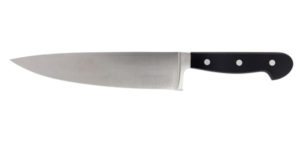
Chef's knife
It'due south right there in the name: The chef's knife is one of the most frequently used and versatile tools in the kitchen. Chef's knives are typically between 8 and 10 inches, although they can be as short as half dozen inches and as long equally 14 inches. You'll use your chef's knife for most of your slicing during food prep, and in many ways, information technology will be the well-nigh of import tool y'all use.
The more than comfortable you feel with the weight and rest, the more speedily you'll be able to slice, dice and julienne vegetables during prep for a busy meal service. You're looking for a knife that gives you a smoothen and fast rhythm equally you're cutting.
Escoffier chef teacher shows you how to acuminate your knife.
Paring Knife
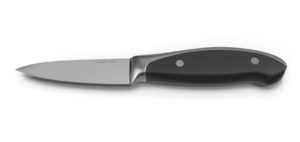
Paring pocketknife
A dent knife is basically a small chef'southward pocketknife, and should be used for the same tasks on a smaller calibration, especially those requiring more precision. Don't use this kind of knife for any difficult vegetables, since its light weight tin can cause you to apply an dangerous amount of force. Paring knives are great for peeling, mincing and detailed cutting.
The blade will be no longer than 3.5 inches…platonic for detail work like creating a garnish. A paring knife is useful when you're working with small or tender vegetables and fruit – ginger, strawberries, garlic, shallots – just isn't suited for harder vegetables – carrots, beets, squash. You never want to apply force with a dent pocketknife…choose a heavier bract for the harder tasks to avoid injury.
Utility Knife
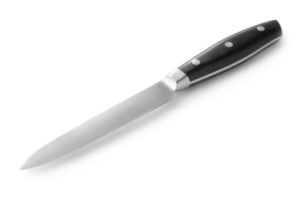
Utility knife
As the proper name suggests, this is a commonsensical knife – it does multi-duty. The blade is longer than a paring knife and more narrow than a chef's knife. A utility knife is by and large six inches long and works well slicing fruit, tender pieces of meat or sandwiches. The "knife of all trades," information technology'southward a handy become-to for the everyday chef.
Boning Knife
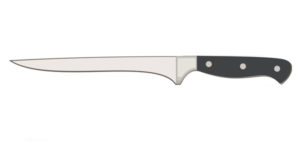
Boning Knife
Long, sparse and stiff, this knife is used to remove meat from the bone. Its thinness allows you to move with the curves and bends of the bone and separate the meat effectively, leaving as piffling behind every bit possible. When using a boning knife, do not try to cut through bones.
There are 2 versions of a boning knife, and both have a specific purpose. If you look at a chef's knives, yous'll likely detect both in their collection. A boning knife is narrow, comes to a very abrupt bespeak, and is unremarkably five or six inches long. Information technology will have either a flexible or stiff blade. The flexible blade is suitable for removing pare and bones from poultry and fish. The stiff blade allows the utilize of greater force when you're working with thick cuts of meat like beef and pork.
Breadstuff Knife
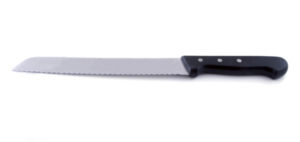
Breadstuff knife
Once again, this knife'south name is not specially subtle. The staff of life pocketknife cuts through bread. Its serrated border lets information technology piece bread without fierce the loaf apart.
The saw-like blade of a staff of life knife – or serrated pocketknife – is ideal when you want to cut something without applying pressure. It'southward peachy for gently slicing fresh bread, but also works well with soft fruits and vegetables, or ones that have a waxy surface. A serrated knife comes in handy when you're slicing tomatoes, apples, citrus, or bong peppers. The sawing movement gently cuts through the surface without crushing the insides…though the cut won't necessarily await every bit make clean every bit the one you'll get with a etching pocketknife.
Keeping a bread knife sharp can be a challenge since you lot need a special tool to sharpen each surface of the jagged blade…but it's worth the effort.
Carving Knife
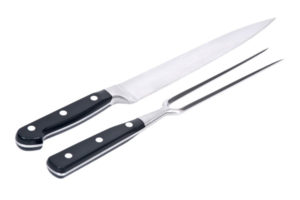
Carving knife
When you want a make clean, precise cutting, the carving knife is ideal. A good etching pocketknife is unremarkably fifteen inches long. Its thin blade, and indentation that stops food from sticking to the surface, brand it the perfect choice when carving turkey, ham, pork or a beef roast. Whether yous're slicing a sirloin roast into paper-thin slices or a pork tenderloin into thick, juicy portions, a carving knife is the perfect tool.
Cheese pocketknife
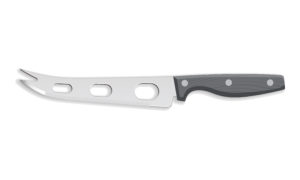
Cheese knife
Soft cheeses oftentimes stick to knives, which is why cheese knives accept holes in them. These holes reduce the cheese's surface contact with the knife, and cuts down on sticking. Be mindful of the sharpness of your knife when cutting cheese, equally harder cheese volition require a sharper knife.
Tomato pocketknife
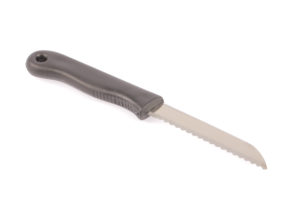
Tomato knife
Tomatoes are notoriously hard to slice because their skin is prone to violent. Very small serrations on the tomato knife's bract grip the skin of the tomato and reduce tears, allowing you to piece through easily.
Cleaver
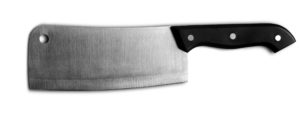
Cleaver
Cleavers are heavy, sharp knives used to cut through bones. Their size and weight help yous drive them downward through meat and bones, letting you set your meat yourself. While this pocketknife isn't particularly mutual in home kitchens, many chefs in restaurants use them, so they take total control over their cuts of meat.
While the chef's knife reigns supreme in Western kitchens, The Kitchn claims that the cleaver is the most versatile knife in Chinese kitchens. In add-on to cutting through meat and bones, in China, they accept the place of everything from a pairing knife to the chef'due south. If y'all're interested in investing in a cleaver, consider a Chinese-fashion one. These knives are lighter than their American counterparts, making them useful for many more kitchen tasks.
Mincing pocketknife
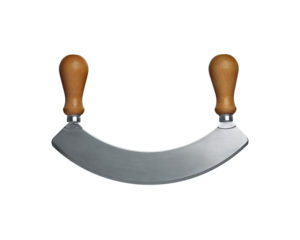
Mincing pocketknife
A mincing knife is a curved knife that is held with both hands and used by rocking information technology dorsum and forth. This knife can apace mince vegetables or herbs into very small pieces with minimal endeavour.
Decorating knife
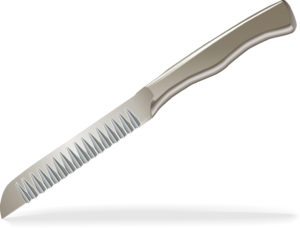
Decorating knife
If a chef wants his or her nutrient to accept a designed edge (for example, cut in a zig-zag pattern), he or she tin can use a decorating pocketknife. Decorating knives have patterns in the blade that appear on the foods it cuts.
Keep Knives Sharp with a Honing Rod
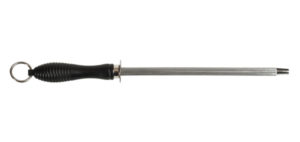
Honing Rod
It'due south of import to accept the right knife for the task…just just as of import to accept the right tool to keep a sharp edge on your chef'due south knives. A honing rod should be part of your drove…
There's a technique to using a honing rod that volition work with all your knives – except your serrated knives. Be certain to sharpen them before or after a session in the kitchen. Tedious blades volition slow y'all down and also increment the risk of injury…they tin can slip off the food yous're trying to cut and slice you, instead.
There are so many skills and techniques you lot'll acquire at culinary school…like learning the alphabet in chief school, knife techniques are a foundation for chefs. Having the right tools in your kitchen – whether you're an amateur or aspiring chef – will help with your journey as you brand your fashion in the culinary earth.
Like this article? You may also like:
- How to Become a Chef: The Complete Guide
- The Latest in Food Tech
- How Culinary Students Explore Flavor Profiles
Subscribe to Weblog
Related Articles
mitchellposeveropme.blogspot.com
Source: https://www.escoffier.edu/blog/culinary-arts/different-knives-and-the-best-uses-for-each/
Belum ada Komentar untuk "What Type of Knifes Are Used in Art Classrooms"
Posting Komentar